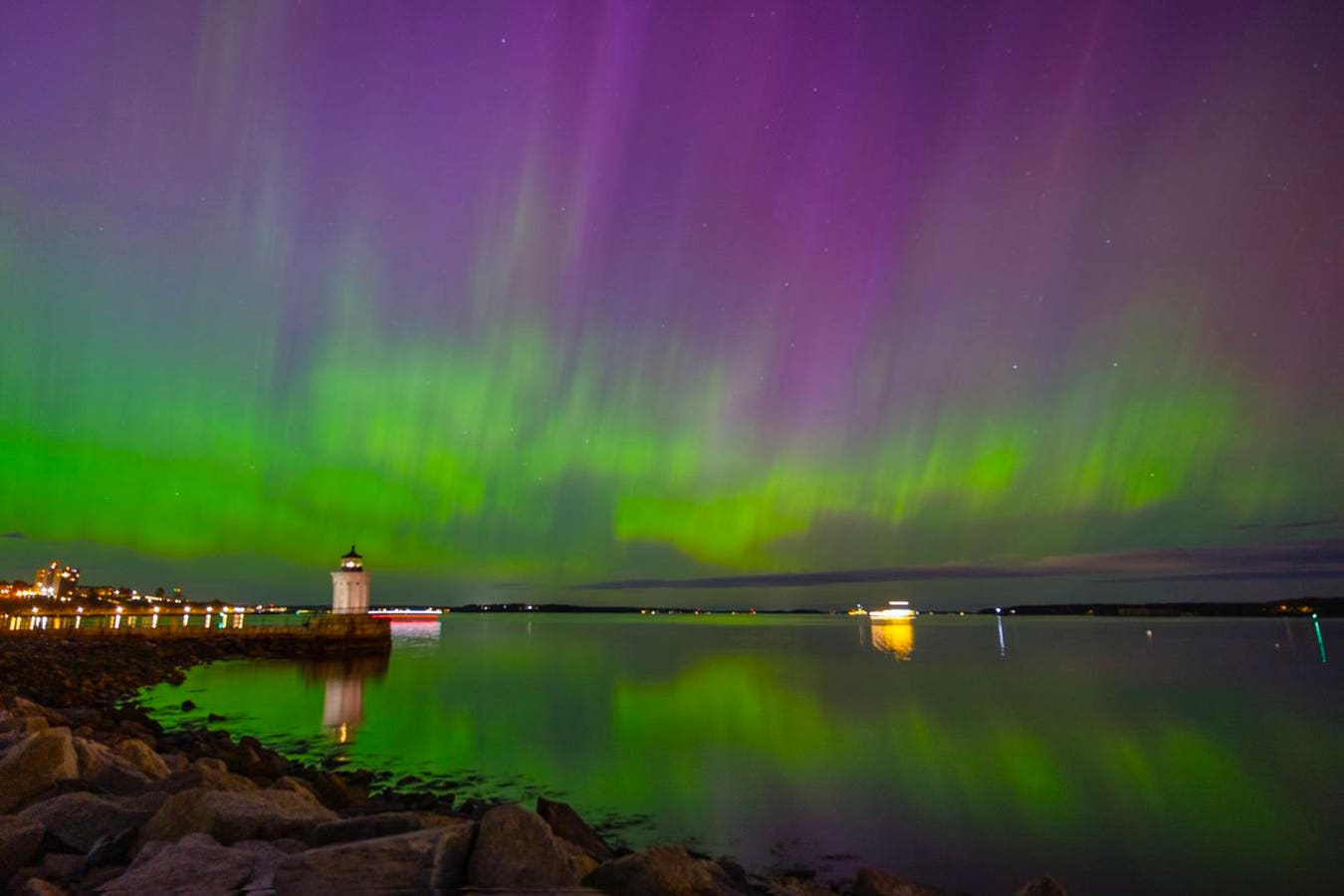A huge solar storm brought an aurora borealis display bright enough to see with the naked eye on May … More 10th, 2024.
getty
Update, May 29, 2025: The very latest NOAA forecast has 15 states in line to see aurora after a G2 geomagnetic storm was predicted overnight on May 29 to May 30.
The Northern Lights may be visible overhead and/or in northern skies from 10 U.S. states on Thursday, May 29 through Saturday, May 31, 2025, after a spike in geomagnetic activity.
The lack of moonlight (there was a new moon on Monday) and the effect on darkness hours due to Earth’s tilt as we approach the solstice on June 21 make the U.S. currently one of the best places to see the Northern Lights.
Despite predicting only a low-level G1 geomagnetic storm this week, space weather forecasters at the National Oceanic and Atmospheric Administration later upgraded it to a much stronger G3-rated event. “A G3 (Strong) geomagnetic storm was observed at 29/0216 UTC in response to negative polarity coronal hole high speed stream influences,” read its tweet. “A G3 warning is valid until 29/0600 UTC. Stay tuned for updates.”
ForbesWhy Americans Are Now In The Best Place To See The Northern LightsBy Jamie Carter
Why Space Weather Is Unsettled
The dramatic events — which saw aurora as far south as Italy — are indicative of unsettled space weather, which could see more aurora in the U.S. this week.
“Active to G1 (Minor) storm levels are likely through 30 May as we transition into another negative polarity CH HSS,” states NOAA. “Unsettled to active levels are expected on 31 May.”
Update: this was later upgraded to a G2 geomagnetic storm on May 30 and a G1 geomagnetic storm on May 31 and June 1.
Negative polarity CH HSS refers to the orientation of the magnetic field and the fact that the solar wind is coming at high speed (HSS) from a coronal hole (CH), a cooler, darker region in the sun’s corona. A coronal hole — which allows the solar wind to escape more easily into space and which is very common in the present solar maximum period — has been facing Earth all week.
Negative polarity means the magnetic field lines in the solar wind point toward the sun. If the magnetic field in the solar wind points southward, a geomagnetic storm may be triggered — resulting in auroras at mid to high latitudes.
NOAA’s updated aurora viewline prediction for Thursday, May 29, 2025.
NOAA
U.S. States That Could See Northern Lights
NOAA has also dropped an aurora viewline forecast that indicates that aurora may be seen from 17 U.S. states.
According to NOAA, this G1 storm may be seen in northern skies from northern Washington, northern Idaho, Montana, northeast Wyoming, North Dakota, South Dakota, Minnesota, Wisconsin, Michigan and Maine. Regions closest to the border with Canada will have the highest possibility of seeing the aurora.
The potential displays of aurora borealis tonight have a predicted Kp index of 4. According to NOAA, that means “the aurora will move further from the poles, it will become brighter, and there will be more auroral activity (motion and formations). If you are in the right place, these aurora can be quite pleasing to look at.”
NASA’s solar observatory detected an X1.1 class solar flare on the sun on May 25, which caused a shortwave radio blackout over the Pacific Ocean, according to Spaceweather.com. It was followed the same day by two lesser M3.4 and M8.9 solar flares.
Viewing Tips For The Northern Lights
Here are some tips for seeing the aurora:
- Check NOAA’s Aurora Dashboard and be ready to head out at a moment’s notice if conditions look favorable. Check cloud conditions.
- Get as far away from city lights as possible to maximize your chances of seeing the aurora because they’re more impressive in a dark sky. Use a light pollution map or the Dark Sky Place finder to find a suitable location away from city lights.
- Prioritize a dark northern horizon since that’s likely where they’ll be visible (don’t, for example, observe from south of a huge city).
- Dress warmly and have a plan for how you’ll get home safely.
- While you’re out, use an app like Glendale App or a website like SpaceWeatherLive.com and look at both the Kp (you’re after Kp 6 or 7, or higher) and a strong southward Bz figure, which indicates that it might connect with Earth’s magnetosphere to cause a substorm.
- Be prepared to fail and be at peace with that before you go out. It may take multiple trips to finally see aurora, as displays can be unpredictable.
Wishing you clear skies and wide eyes.
